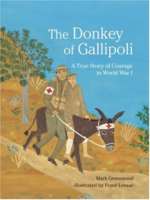
When Jack Simpson was a boy in England, he loved leading donkeys along the beach for a penny a ride. So when he enlists as a stretcher bearer in World War I, his gentle way with those animals soon leads him to his calling. Braving bullets and bombs on the battlefields of Gallipoli, Jack brings a donkey to the aid of 300 Allied soldiers — earning both man and donkey a beloved spot in legend. Two unlikely heroes rescue hundreds of men wounded in war in a poignant picture book based on a true tale of World War I. This engaging nonfiction tale includes a map and brief bios of key characters.
Featured in WOW Review Volume X, Issue 2.
Related: England (UK), Nonfiction, Picture Book, Primary (ages 6-9)
- ISBN: 9780763639136
- Author: Greenwood, Mark
- Illustrator: Lessac, Frane
- Published: 2008, Candlewick
- Themes: Courage, Rescues, World War I
- Descriptors: England (UK), Nonfiction, Picture Book, Primary (ages 6-9)
- No. of pages: 32

I agree, Tracy, this story has the potential to open up multiple inquiries especially if it’s presented as part of a text set with some of the great stories you’ve listed in your post. I, like you, have a broad and somewhat limited understanding of WWI, mostly gleaned from textbooks I read in history classes. The Donkey of Gallipoli helped fill in some of the gaps I have about WWI. Jack’s story also provided me with that human element that makes stories come alive. Jack’s yearning for adventure is similar to my own desire to travel and explore the world. When Jack longed to return home to England to be with his family and friends, I could relate. Like Jack, I feel a pull to be in my childhood home with my family at times. I marveled at the way Jack’s boyhood experiences with donkeys helped him rescue over 300 soldier from the battlefields and I thought about how my own childhood experiences have influenced my adult life. As you can see, my connections to Jack’s feelings certainly enhanced my enjoyment of this story.
I haven’t shared this story with an audience yet. I wonder how young readers whose knowledge about WWI might be even more limited than ours will respond to Jack’s story. I hope to share it with a high school social studies teacher I work with from time to time. He strives to bring history alive for his students by providing intimate snapshots of large scale events; that is, intimate stories like Jack’s role at Gallipoli embedded in the events of WWI. I’m looking forward to seeing how his high school students respond!
There have been several wonderful children’s books published in the last couple of years featuring donkeys and mules, like Belle, The Last Mule at Gee’s Bend: A Civil Rights Story (2011)
by Calvin Alexander Ramsey and Bettye Stroud with illustrations by John Holyfield about the mules that carried determined black citizens during the civil rights movement to vote for the first time, and later the casket of Martin Luther King Jr. during his funeral. The Bibilioburro (2010) by Jeanette Winter, about the work of schoolteacher Luis Soriano who, with his faithful burros, carried hundreds of books to children living in remote South American villages. And the focus of this week’s My/Take/Your Take, The Donkey of Gallipoli (2008) by Mark Greenwood with illustrations by Frane Lessac, about Word War I war hero Jack Simpson who, while fighting in Gallipoli, found a lonely frightened mule and together they rescued over 300 men in 24 days amidst the fighting before Jack was shot and killed.
Of course, these books are more about the heroic people “behind the animals,”, than the animals themselves; people who, with their beloved animals and against tremendous odds performed heroic feats in the name of justice and their commitment to humanity.
Jack Simpson’s story is one I’d not heard of before because, I suspect like many other people of my generation, I know little about the stories and events around World War I. What I really appreciate about this book is that it talks about war honestly, not pretending that all ends happily for heroes like Jack, who throughout the book dreams of going home to England, but cannot return because of economic hardship and joins the military in hopes that the war will be his ticket home, which is at all the outcome. I see this as a book that could open up inquiries into the economic realities of soldiers in both historic and contemporary wars, the role of animals in war, and World War I itself. The book includes interesting end notes that provide factual information about the events portrayed in the story.
The Donkey of Gallipoli, as well as the other aforementioned ”donkey” stories, feature real life accounts of extraordinary courage, resilience, and the remarkable relationships between people and animals during time of adversity. Upon reading these books I think you’ll want join me in shouting out to the world,“DONKEYS RULE!”